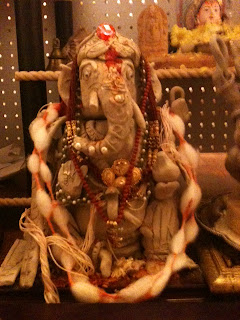For a TMD nothing can be more popular than good ambat bhaji had with phodni and kaathrecha
mirsinga! Aha! Over time, perhaps due to a yearning for the land we had come away from, the TMDs
took Food combinations to a level of ....dare I say it! Here are some of the ones I grew up with ....
I hope readers come out with a few of their own!
Ambat Bhaji with Phodni and Kaathrecha Mirsinga
Well, for the TMDs this mouthwatering combination has no equal in culinary history!
Waran Bhath with Thoop
This simple combination of hot rice, homemade ghee(thoop) mixed with soft cooked Turi dal boiled
with haldi and with a hint of phodni is a great 'Comfort Food' . When feeling low, getting over
sickness, when upset try this and you will feel the warmth of your mother's love in this simple food!
Saar Bhath
I call this another 'Comfort Food' . Saar by itself is a great South Indian delicacy. Saar bhath for
TMDs is a basic. It is so basic that "kheer poli nahithrina, saar bhath " "खीर पोळी नही
तहरहीन सार भाथ" is popularly used to describe this simple food in comparison with rich food like
kheer poli.
Thoop Meeth Bhath
A baby food that is enjoyed by all adults at all times! Just hot rice mixed with homemade ghee and
salt and mixed very well!
Kheer Poli
As mentioned before this is the opposite of Saar bhath. While saar bhath is everyday food, kheer poli
graces special occasions. It is made on sanach divas, festival days., special puja days.
Perhaps, this is one more tradition we carried from our origins! The tradition of making Kheer Poli.
This is in total contrast to the Tamils, whom we emulate in language, due to living with them for so long!
Tamilians make "vadai payasam" whereas we never make "vadai and payasam combination
except on inauspicious days!
PURAN POLI..A special mention.
All over Maharashtra making puran polis for festivals is important, so it is for us.
For festivals, Puran poli is very often made and enjoyed with ghee or milk or just plain!
Goddu Saar with Roasted pappad
This used to be a popular combination when one has had a heavy lunch outside, maybe a wedding or so
and dinner is at home. This existed in the days before a refrigerator became a household name and
keeping food in the frig and having the next day was unknown!
So it was unwise to make a full evening meal and have to deal with leftovers, that is when this combo
of Godde Saar with bhaajalthe pappad became popular! This combination is I think lost by the advent
of the refrigerator and Take Out meals!
Kadhi Ambode
This is even today made during festival days. Kadhi is made in combination with Ambode
and the ambode is soaked in the khadi and had.
This Ambode, soaked in Kadhi has no equal in taste! It is also called Korada Ambode.
Pitla with fried oil and fried pappad.
Strange? Well, strange it may sound but tasty it is! This typical TMD dish pitla is had with
thallathe thel and thallathe pappad!


.JPG)
.JPG)
.JPG)
.JPG)
.JPG)
.JPG)



